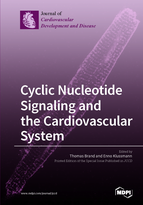Cyclic Nucleotide Signaling and the Cardiovascular System
A special issue of Journal of Cardiovascular Development and Disease (ISSN 2308-3425).
Deadline for manuscript submissions: closed (20 December 2017) | Viewed by 109663
Special Issue Editors
Interests: heart development; cardiac pacemaker development and function; popeye genes; cAMP signaling
Special Issues, Collections and Topics in MDPI journals
2. DZHK (German Center for Cardiovascular Research), partner site Berlin, 10785 Berlin, Germany
Interests: A-kinase anchoring proteins (AKAPs); phosphodiesterases (PDEs); PKA; heart failure; compartmentalized cAMP signalling; vasopressin
Special Issue Information
Dear Colleagues,
The Journal of Cardiovascular Development and Disease (JCDD) is launching a Special Issue on “Cyclic Nucleotide Signaling and the Cardiovascular System”. JCDD is a peer reviewed online journal, in its fourth year of existence, which publishes review articles and original works on cardiovascular development and disease.
Cyclic nucleotides 3’,5’-adenosine monophosphate (cAMP) and 3',5'-cyclic guanosine monophosphate (cGMP) play important roles in the control of cardiovascular function under physiological and pathological conditions. They are produced by adenylate and guanylate cyclases, respectively, bound by different effector proteins, and are subsequently degraded by phosphodiesterases. These proteins form nanodomains in specific locations in cardiac myocytes, such as the plasma membrane, t-tubules, and the nuclear envelope. Thereby, a highly-compartmentalized regulation of essential functions of cardiac myocytes, such as calcium cycling, excitation-contraction coupling, and cell–cell cohesion, is achieved. The use of life cell imaging techniques, such as Förster resonance energy transfer (FRET)-based cyclic nucleotide biosensors and nanoscale scanning ion conductance microscopy (SICM), makes it possible to visualize cyclic nucleotide signaling at very high optical resolutions. Likewise, the importance of A-kinase anchoring proteins and phosphodiesterases to assemble specific signaling complexes in a compartment-specific manner have been thoroughly studied using a variety of advanced techniques. To this end, in cardiac myocytes several effector proteins are expressed namely protein kinase A (PKA) cGMP-dependent protein kinase (PKG), exchange factor directly activated by cAMP (EPAC), hyperpolarization-activated cyclic nucleotide gated channels (HCN) and the Popeye domain containing (POPDC) proteins, which participate in different aspects of signaling. Through the use of effector protein-specific agonists and antagonists and alternatively, with the help of genetic experiments, insight into their individual roles and cross-talk have been obtained. The importance of the cyclic nucleotide pathway in both health and disease cannot be underestimated and up-to-date reviews of this important scientific field will be provided.
Prof. Dr. Thomas Brand
Dr. Enno Klussmann
Guest Editors
Manuscript Submission Information
Manuscripts should be submitted online at www.mdpi.com by registering and logging in to this website. Once you are registered, click here to go to the submission form. Manuscripts can be submitted until the deadline. All submissions that pass pre-check are peer-reviewed. Accepted papers will be published continuously in the journal (as soon as accepted) and will be listed together on the special issue website. Research articles, review articles as well as short communications are invited. For planned papers, a title and short abstract (about 100 words) can be sent to the Editorial Office for announcement on this website.
Submitted manuscripts should not have been published previously, nor be under consideration for publication elsewhere (except conference proceedings papers). All manuscripts are thoroughly refereed through a single-blind peer-review process. A guide for authors and other relevant information for submission of manuscripts is available on the Instructions for Authors page. Journal of Cardiovascular Development and Disease is an international peer-reviewed open access monthly journal published by MDPI.
Please visit the Instructions for Authors page before submitting a manuscript. The Article Processing Charge (APC) for publication in this open access journal is 2700 CHF (Swiss Francs). Submitted papers should be well formatted and use good English. Authors may use MDPI's English editing service prior to publication or during author revisions.
Keywords
cyclic nucleotides
nanodomains
anchor proteins
phosphodiesterases
effector proteins








